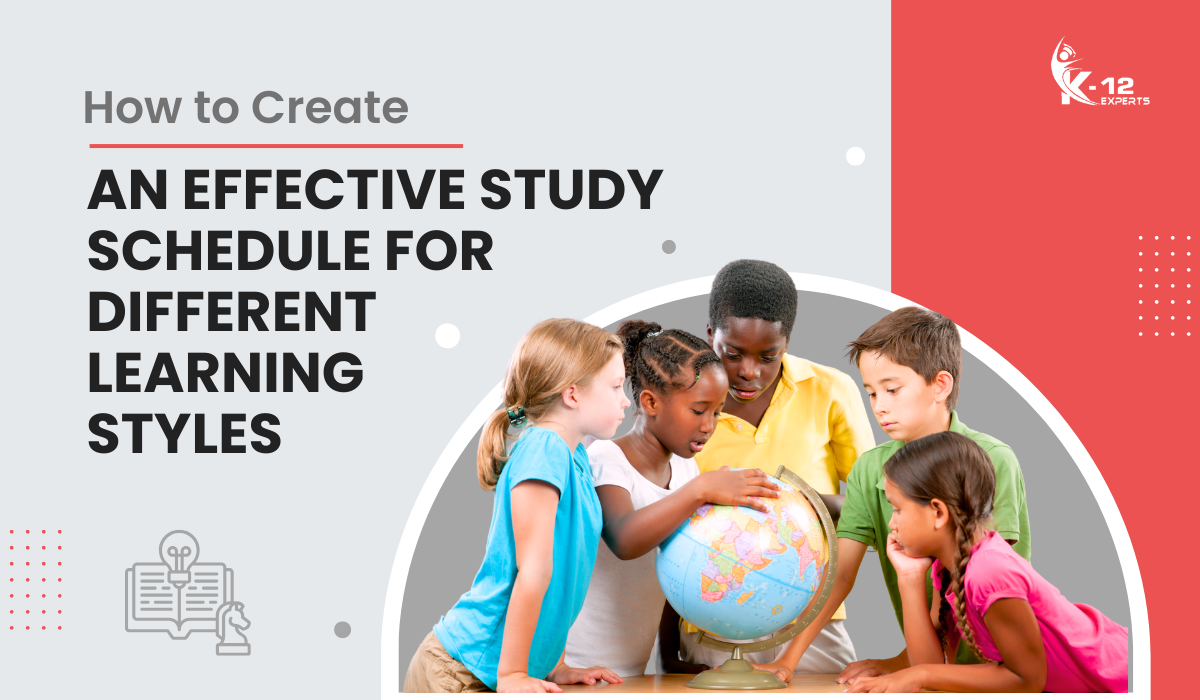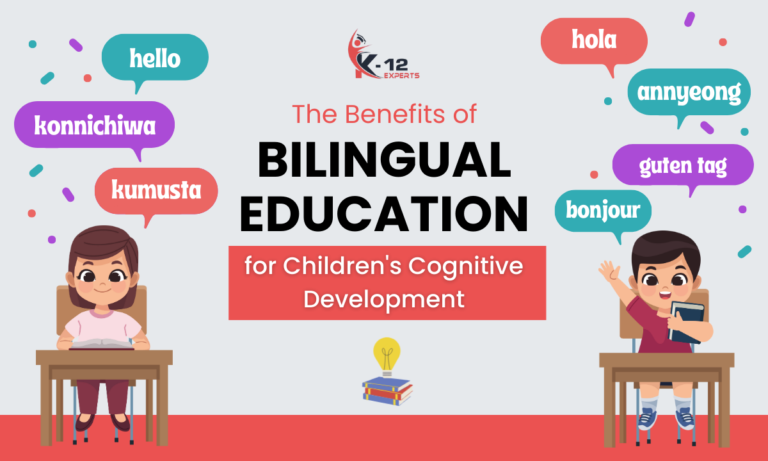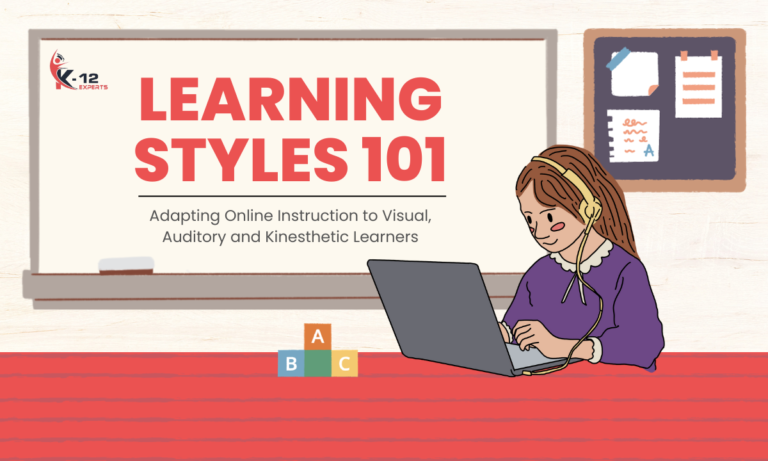Have you thought about how your learning style affects your study habits? Understanding whether you’re a visual learner who learns best through pictures and charts or a kinesthetic learner who prefers hands-on activities can help you create a study schedule that works for you.
By recognizing your preferences, you can tailor your study sessions to suit your needs. For example, visual learners might use mind maps and flashcards, while kinesthetic learners can incorporate practical exercises.
Including regular breaks, using tools like the Pomodoro Timer, and reviewing material consistently will also help improve focus and retention.
Matching your study schedule to your learning style can make studying more enjoyable and productive.
Understanding Different Learning Styles
Understanding your learning style can significantly enhance your study effectiveness.
Learners typically fall into four categories: visual (prefer pictures/diagrams), auditory (favor listening), kinesthetic (hands-on activities), and reading/writing (enjoy reading and note-taking).
You can improve retention and comprehension by identifying your style and tailoring your study methods, such as charts for visual learners or discussions for auditory learners.
Visual Learners
Many people, about 65%, learn best through visual methods. This means they understand information more easily when it’s presented with images, diagrams, or charts.

Visual tools like flashcards, concept maps, and infographics can help visual learners create effective study schedules. These tools can also make it easier to organize and review what they’ve learned.
When you encounter complicated ideas, try turning text into visuals. For example, if you’re studying math, you could draw graphs or use color-coded notes to help visualize problems.
Visual learners often excel in subjects like math, engineering, and art, so it’s good to focus on those areas.
Additionally, using digital resources like educational videos or interactive simulations can enhance learning. Websites like Khan Academy or YouTube have great visual content that can explain tough concepts.
Auditory Learners

Auditory learners thrive when engaging with sound and spoken words. To optimize learning, incorporate listening activities such as attending lectures, participating in discussions, and utilizing audiobooks or podcasts.
Study groups can also enhance understanding through peer discussions.
Additionally, recording and reviewing audio notes allows for personalized and effective study sessions, reinforcing material through auditory repetition.
Kinesthetic Learners
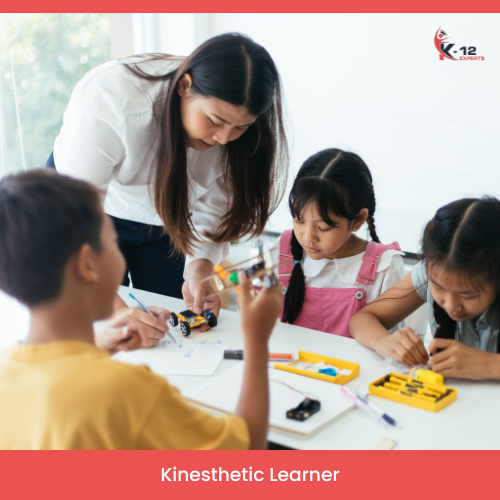
To help kinesthetic learners study more effectively, here’s a study schedule incorporating hands-on learning strategies. This plan emphasizes active participation, real-world experiences, and practical applications:
- Try Experiments: Conduct simple science experiments at home or in a lab. This helps you understand concepts better. For example, if you’re studying chemistry, you can mix baking soda and vinegar to see a reaction.
- Use Hands-On Materials: Find models or tools that you can manipulate. For instance, if you’re learning about the solar system, use a model of the planets to see how they relate to each other.
- Get Involved in Fieldwork: Look for opportunities to apply what you’ve learned in real-world settings. This could mean doing an internship or job shadowing someone in your desired field. Experiencing tasks firsthand can deepen your understanding.
- Engage in Projects: Work on projects that require you to use your knowledge in practical ways. For example, if you’re studying environmental science, you could create a small garden to learn about plant growth and ecosystems.
Reading/Writing learners
Kinesthetic learners love hands-on activities, but if you’re more of a reading/writing learner, you probably learn best by engaging with the material through reading and writing.

To maximize your study time, try summarizing what you’re learning and taking detailed notes during class. This is especially helpful for subjects like languages and literature, where writing is key.
Don’t overlook digital tools, either. Reading e-books or online articles can give you a broader view of topics, and writing reflections helps reinforce what you’ve learned.
One tried-and-true method for note-taking is the Cornell method, which helps organize your thoughts and makes studying way easier later on.
Creating a Personalized Study Schedule
Creating a personalized study schedule starts with understanding your learning style, which helps you tailor your study habits effectively. For instance, visual learners might benefit from diagrams and color-coded notes.
Once you know how you learn best, set achievable goals by breaking tasks into smaller, manageable steps. Prioritize tasks based on importance and deadlines, using tools like Trello or Google Calendar to stay organized.
Lastly, don’t forget to schedule regular breaks to stay focused and avoid burnout, making your study time more productive.
Assessing Your Learning Style and Needs
Understanding how you learn and what you need is key to building an effective study plan.
Here are a few steps to help you figure out your preferences:
- Identify strengths and weaknesses: Consider the subjects or tasks you find easy and those that challenge you. For example, if you struggle with math but excel in writing, this will guide your focus.
- Determine your learning style: Figure out if you learn best by seeing (visual), listening (auditory), doing (kinesthetic), or reading/writing. For instance, if you remember information better when you see diagrams or charts, you might be a visual learner.
- Set clear goals: Consider what you want to achieve in your studies. Whether it’s passing an exam or mastering a new skill, having specific goals can keep you motivated.
- Identify areas for improvement: Look at the subjects or skills that need extra attention. If you find that you often forget what you read, you might need to spend more time practicing reading comprehension techniques.
Setting Realistic Goals and Timeframes

To create a study schedule that works, you need to set goals and timeframes that fit with your learning style and daily responsibilities. Start by breaking big tasks into smaller, more manageable steps. This way, you can track your progress easily, which helps keep you motivated.
Think about your strengths, weaknesses, and other commitments outside of studying. This will give you a clearer picture of how much time you can realistically dedicate to your studies without feeling stressed.
Prioritizing Tasks and Managing Time Effectively
Effective time management is essential for improving your study routine. Begin by identifying which tasks are most important, then decide how much time you’ll need for each.
Here are a few helpful tips:
- Make a to-do list: Rank your tasks by urgency and importance so you can focus on what matters most first.
- Stay organized: Use a planner or digital tools like Todoist or Google Calendar to keep track of everything in one place.
- Minimize distractions: Find a quiet study space, turn off phone notifications, or use noise-canceling headphones to stay focused.
- Time-blocking: Set specific chunks of time for each task to help you stay on track and avoid procrastination.
Incorporating Breaks and Rest Periods
Regular breaks are important to keep your study sessions productive. They allow your brain to rest and recharge, improving focus and retention.
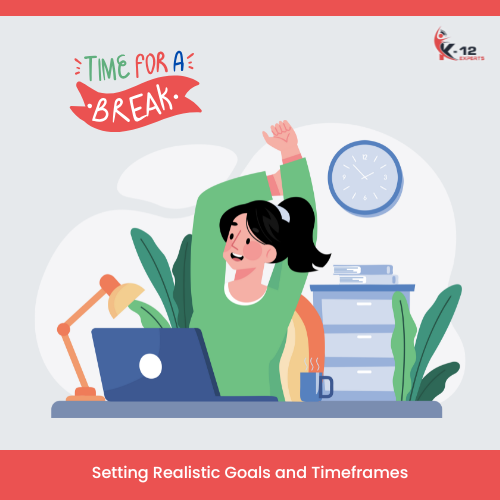
A good rule of thumb is to study for about 25-30 minutes, then take a short break. Use your break to stretch, grab a drink, or take a walk. After two or three study sessions, take a longer break to relax and process what you’ve learned.
Everyone has their own rhythm, so experiment with different break schedules to find what works best for you. Balancing study time with regular breaks makes the whole process more enjoyable and effective.
Study Schedule Strategies for Each Learning Style
To create an effective study schedule, it’s important to consider your learning style. If you’re a visual learner, use charts, graphs, or colorful notes to help with memory. Auditory learners might benefit from listening to lectures or discussing topics with others, while kinesthetic learners can focus on hands-on activities or experiments to grasp concepts.
Writing detailed notes or summaries is key to reinforcing reading/writing learners’ understanding. Matching your study methods to your learning style will improve retention and make studying more enjoyable.
Visual Learners: Utilizing Visual Aids and Diagrams
Using Visual Aids and Diagrams Visual learners understand best when information is clear and structured.
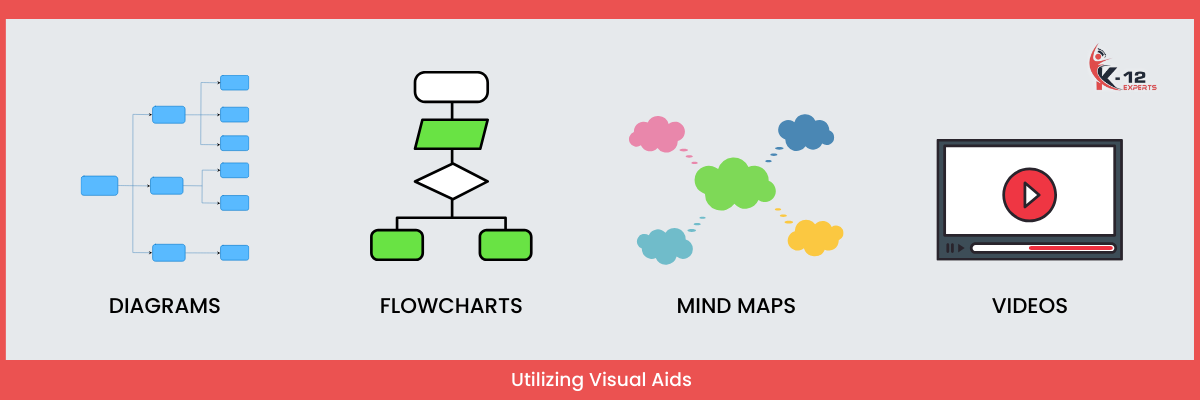
Try these strategies to make studying more effective:
- Diagrams: Use them to show how different processes work together. For example, a diagram can illustrate the water cycle, making it easier to understand.
- Flowcharts: These can break down complicated topics. For instance, a flowchart can help summarize the steps in a scientific experiment.
- Mind Maps: These are great for linking different concepts visually. You might create a mind map to connect ideas in a book or a project you’re working on.
- Videos: Watching videos can help you engage with content in a lively way. Consider educational YouTube channels that explain subjects through animations.
Incorporating these visual aids can enhance your understanding and retention of information.
Auditory Learners: Recording Lectures and Engaging in Discussions
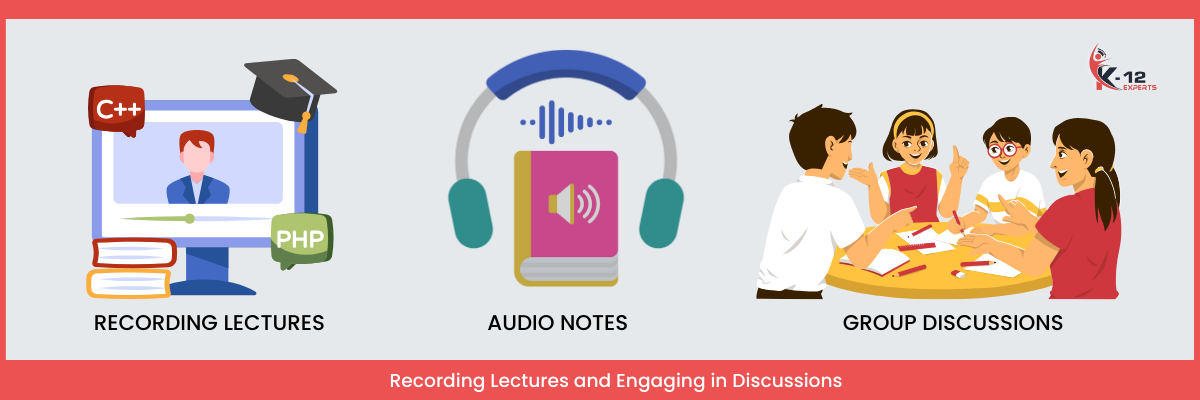
Listening and Discussions For auditory learners, sound plays a key role in learning.
Recording lectures and listening to them again can help you understand the material better. This repetition makes it easier to remember what you’ve learned.
Joining group discussions is also helpful because you get to hear different viewpoints, which can deepen your understanding through conversation.
Create your own audio notes, like voice recordings or even podcasts, so you can review the content whenever you want. Adding music or making up rhymes can also help you remember information more easily.
Set aside specific periods to listen to your recordings and participate in discussions to maximize your study time.
This way, you can take full advantage of your strengths as an auditory learner and improve your academic performance.
Kinesthetic Learners: Hands-on Activities and Real-World Applications

Hands-on Activities Kinesthetic learners grasp concepts best through hands-on experiences.
These methods can enhance your learning:
- Perform lab experiments to see how theories work in real life. This can be especially helpful in science subjects, where you can mix chemicals or observe reactions.
- Join simulations that recreate real-life situations. For example, if you’re studying business, you might participate in a mock negotiation or marketing strategy session.
- Take part in project-based learning. This could involve creating a model, building a prototype, or designing a presentation showcasing your learning.
- Use manipulatives like building blocks, puzzles, or 3D models. These tools can help you visualize complex ideas and make them easier to understand.
Remember to move around and take breaks to stay focused and boost your memory.
Reading/Writing learners: using notes and written summaries

Notes and Summaries Reading/writing learners absorb information through written content.
To optimize your study time, try these approaches:
- Detailed Notes: To keep your notes organized, use headings, subheadings, and bullet points.
- Concept Maps and Outlines: Visualize connections between ideas to deepen understanding.
- Flashcards and Quizzes: Actively engage with the material through self-testing.
- Journals and Essays: Reflect on what you’ve learned by writing, helping reinforce and clarify your understanding.
Writing and organizing your thoughts will strengthen your comprehension and critical thinking.
Adapting and Refining Your Study Schedule
Learning is an ongoing journey, and adjusting your study schedule is key to doing well in school. As you grow and change, your study habits should, too. Take some time to evaluate how you study and look for ways to make it better.
Here are some suggestions:
- Try out new study methods that fit how you learn best. For example, use diagrams or videos if you’re a visual learner.
- Change how often and how long you study. Maybe shorter, more frequent sessions work better for you than long marathons.
- Mix up your study materials. Use books, apps, and videos to keep things interesting.
- Seek feedback from classmates or teachers. They can offer helpful insights that you mightn’t have considered.
Stay open to experimenting with different approaches. This flexibility will improve your learning and help you reach your academic goals.
The most important thing is to create a study plan that grows with you.
Frequently Asked Questions
How Can I Motivate Myself to Stick to a Study Schedule?
Set specific, achievable goals, break tasks into smaller steps, reward progress, and use different study methods. Stay flexible and maintain a positive mindset to adapt to challenges.
What Tools Can I Use to Track My Study Progress?
Use digital planners, habit-tracking apps like Habitica or Streaks, or customized spreadsheets like Google Sheets to monitor your study habits and track progress.
How Often Should I Review My Study Schedule?
Review your schedule weekly to adjust it based on your learning needs and ensure it aligns with your goals.
Can I Combine Different Learning Styles in My Schedule?
Yes, mix visual aids, lectures, and hands-on activities for a more engaging and effective study plan that suits your preferences.
What Should I Do if I Miss a Study Session?
Rearrange your schedule and focus on key topics. Stay adaptable and avoid stress by adjusting your plans as needed.

